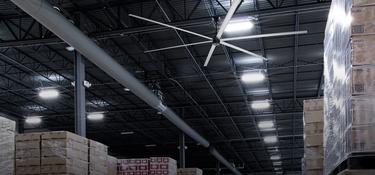
As temperatures rise and weather patterns become increasingly unpredictable, warehouse operators face significant challenges, particularly during the sweltering summer months. Ensuring a safe and comfortable working environment is not just a regulatory requirement; it’s also a fundamental aspect of warehouse efficiency and employee well-being. To address the heat, it’s important to take a multifaceted approach that includes both employee-focused measures and infrastructural improvements.

Address Heat-Related Risks
Warm work environments can severely affect warehouse employees. According to the Occupational Safety and Health Administration (OSHA), heat-related illnesses affect thousands of workers annually.1 Prolonged exposure to high temperatures can cause heat exhaustion, heat stroke and other serious conditions. The physically demanding nature of warehouse work, coupled with often-inadequate ventilation, exacerbate the risks. With rising temperatures, a comfortable work environment is essential—for compliance and, more importantly, employee health, well-being, job satisfaction and retention.
People-Centric Strategies
Warehouse operators combat the effects heat can have on employees in various ways, and it’s increasingly common for facilities to appoint safety ambassadors. These team members monitor the work environment and encourage employees to take breaks. Additional resources, such as onsite ice machines along with access to water and other hydration, further support employee well-being.
Infrastructure Enhancements
To effectively manage heat and ensure a comfortable working environment, warehouse operators focus on broad infrastructural enhancements, many of which improve airflow and lower energy use, contributing to overall warehouse efficiency.
High-volume, low-speed fans
High-volume, low-speed (HVLS) fans are highly effective in large spaces like warehouses because they move substantial volumes of air with optimal energy efficiency. Additionally, HVLS fans help improve air quality by circulating fresh air and reducing humidity levels. They further support energy efficiency by reducing the need for air conditioning, which helps lower operational costs.
- Temperature regulation: HVLS fans create a cooling effect that can reduce perceived temperatures in a logistics facility by up to 10°F,2 significantly enhancing the work environment and enabling productivity.
- Easy installation: HVLS fans are designed for easy installation in existing structures. They require low maintenance and little energy, making them a cost-effective, long-term solution.
Dock door fans
Dock door fans are essential to manage heat in loading dock areas and docked trailers, where warm air often accumulates. Installed near loading docks, these fans are critical for workers during loading and unloading activities. By maintaining a steady flow of fresh air, dock door fans provide significant benefits:
- Enhanced air circulation: Dock door fans ensure continuous airflow, effectively reducing heat pockets and keeping workers cooler as they load and unload trailers.
- Healthier work environment: Dock door fans disperse exhaust fumes and maintain air quality, contributing to overall employee health and safety, especially in docked trailers and loading areas with heavy equipment operation.
Rooftop solar panels
Commercial solar panels on facility rooftops offer efficiency benefits for all systems that run on high demand during the warm seasons. There is also an additional passive cooling benefit because solar panels provide a shaded barrier on a rooftop, shielding warehouse insulation from absorbing sunlight directly and helping regulate HVAC use.3
- Cost savings: With the renewable energy generated from rooftop solar systems, energy costs can be offset by up 95%,4 which can be extremely beneficial with an uptick in the use of cooling systems during warm seasons.
- Grid resilience: In an era of increasing energy demand, solar power shoulders the load during peak-demand periods. The need for additional power during extreme temperatures magnifies this benefit. Solar reduces the risk of grid failures and blackouts, ensuring uninterrupted service for businesses.
Tackle Seasonal Warehouse Heat
Managing warehouse heat proactively is essential to ensure employee safety and maintain warehouse efficiency during summer months. Comprehensive strategies that include both employee-focused measures and infrastructural upgrades demonstrate a commitment to worker well-being and have a tangible effect on warehouse operations. By preventing heat-related incidents and fostering a productive workplace, your operations can withstand the hottest months.


